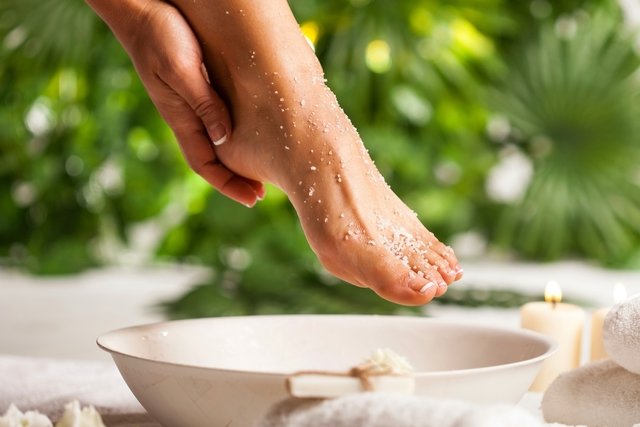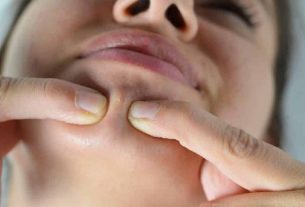Some home remedies to eliminate calluses, such as cornmeal and almond oil scrub, apple cider vinegar, castor oil or baking soda solution, help to exfoliate the skin and increase softness, eliminating dead cells, relieving the pain and discomfort of calluses.
Corns or calluses are hard areas located on the outermost layer of the skin that arise due to the constant friction to which the area is subjected, normally affecting hands, feet or elbows.
These home remedies can help eliminate calluses, however, it is recommended to consult a dermatologist if calluses appear frequently, cause pain or discomfort, or do not improve within 1 week with home measures, so that the most appropriate treatment can be indicated. , which may involve the use of topical medications. Check out which remedies may be recommended for treating calluses.

1. Cornmeal and Almond Oil Scrub
A great way to eliminate calluses is to massage your feet with cornmeal and sea salt, which help to remove hard skin. Furthermore, the presence of peppermint essential oil helps to revitalize the skin and almond oil has a moisturizing action.
Ingredients
- 45 g of corn flour;
- 1 tablespoon of sea salt;
- 1 teaspoon of almond oil;
- 3 drops of peppermint essential oil.
Preparation mode
Mix all the ingredients in a bowl and add warm water to form a consistent paste. Then, massage clean, damp feet with the exfoliant, focusing on rough areas with calluses and then wash with warm water and soap.
2. Lemon and patchouli cream
Lemon essential oil and cocoa butter are great for softening and moisturizing calluses, while patchouli essential oil treats cracked skin.
Ingredients
- 60 g of cocoa butter;
- 10 drops of lemon essential oil;
- 5 drops of patchouli essential oil.
Preparation mode
Place the cocoa butter in a heavy pan and heat over low heat until it melts, then remove the pan from the heat and add the lemon and patchouli essential oils to the melted butter, stirring. Pour the mixture into a bottle, let it cool and massage your feet with the cream before going to sleep.
3. Apple cider vinegar
The acidity in apple cider vinegar helps soften the callus and speeds up the healing process.
Ingredients
- 1 cotton swab;
- 1 spoon of apple cider vinegar.
Preparation mode
Dip a cotton swab in apple cider vinegar and apply it to the calluses before bed, and leave it on overnight. The next day, exfoliate the area with a pumice stone and apply a little coconut oil or olive oil to moisturize. Repeat as necessary until the callus disappears.
4. Chamomile tea
Chamomile tea helps soothe the skin, as well as softening calloused skin and relieving discomfort.
Ingredients
- 1 teaspoon of dried chamomile flowers;
- 1 liter of water.
Preparation mode
Put the water to boil and then turn off the heat. Add the chamomile flowers to this water, cover and let it rest for 5 minutes.
Then, add this tea to a basin, wait for it to warm and dip your feet with calluses in this solution, leaving it to soak for around 10 to 15 minutes. After this period, wash your feet with soap and water, as chamomile can leave your skin stained. Dry well and apply a moisturizing cream.
Another option is to use chamomile tea bags on areas with calluses.
5. Foot bath with Epsom salts
Epsom salts are rich in magnesium sulfate which is easily absorbed by the skin, facilitating blood flow, reducing swelling and pain from calluses on the feet, and promoting the softening of calluses.
Ingredients
- ½ cup of Epsom salts;
- 2 to 3 liters of warm water.
Preparation mode
Add Epsom salts and warm water to a bowl until the salts are completely dissolved. Then soak your feet for about 10 minutes. After this time, you can use an exfoliant to help remove the surface layer of calluses.
Rinse your feet and dry with a clean, dry towel. This process can be done up to 2 times a week.
6. Baking soda solution
The baking soda solution helps soften calluses on the feet, as well as having an exfoliating and antiseptic action.
Ingredients
- 3 tablespoons of sodium bicarbonate;
- 2 to 3 liters of warm water.
Preparation mode
Add the ingredients to a bowl and soak your feet for about 10 to 15 minutes. Then, apply an exfoliant, rinse your feet, dry well, and finish by applying a moisturizing cream.
7. Lemon paste and acetylsalicylic acid
The lemon and acetylsalicylic acid (Aspirin) paste has an exfoliating action, which helps to remove dead skin, eliminating calluses on the feet.
Ingredients
- 5 or 6 acetylsalicylic acid tablets;
- 1 teaspoon of water;
- 1 teaspoon of lemon juice.
Preparation mode
In a clean, dry container, grind the acetylsalicylic acid tablets until they form a powder. Then add the water and lemon juice, mixing well to form a paste. Apply this mixture only to the calluses. To improve the effect and penetration into the skin, cover the callus with plastic and, on top, a warm towel.
Leave it to act for about 10 minutes, and then use an exfoliant or rub the callus gently with a pumice stone to remove the dead skin. Rinse with plenty of water and soap, and then dry your skin.
You must be very careful when using this paste during the summer or when wearing sandals or flip-flops, as the lemon can cause burns to the skin. Here’s how to prevent lemon burn.
8. Castor oil
Castor oil helps to increase hydration, nourish the skin and increase its softness, making it a good option for a home remedy for calluses. See other benefits of castor oil.
Ingredients
- 1 teaspoon of castor oil;
- 100 mL of daily moisturizer or 1 teaspoon of another vegetable oil, such as coconut, avocado or almond oil.
Preparation mode
In a clean, dry container, mix the ingredients and apply to the calluses, massaging lightly until completely absorbed.
Before using castor oil, an allergy test must be carried out, preparing a mixture containing 1 drop of peppermint essential oil in 1 teaspoon of carrier oil, and applying it to the back of the hand or on the elbow bend.
Wait 24 hours and, if during this period the skin becomes red or irritated, it is not recommended to use castor oil for calluses.

Sign up for our newsletter and stay up to date with exclusive news
that can transform your routine!
Warning: Undefined array key "title" in /home/storelat/public_html/wp-content/plugins/link-whisper-premium/templates/frontend/related-posts.php on line 12
Warning: Undefined array key "title_tag" in /home/storelat/public_html/wp-content/plugins/link-whisper-premium/templates/frontend/related-posts.php on line 13




